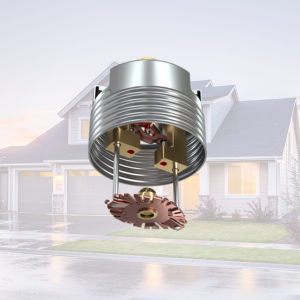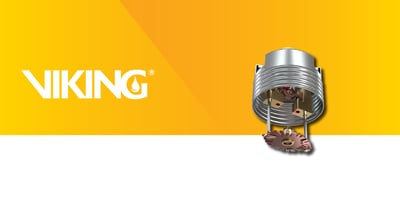We’re excited to announce the newest addition to Viking’s Residential Portfolio: the cULus Listed...
Evolution of Residential Sprinkler Technology
 As seen in Fire Protection Contractor Magazine's March 2024 edition.
As seen in Fire Protection Contractor Magazine's March 2024 edition.
In 1981, Ronald Reagan was sworn in as the 40th President of the United States, NASA launched the first space shuttle and we met Indiana Jones for the first time in Raiders of the Lost Ark. It was also a historic year for the fire sprinkler industry as GRINNELL became the first company to receive a UL Listing for a residential sprinkler. This marked the beginning of one of the most successful life safety technologies ever developed and spurred over 40 years of ongoing development that has led to many lives saved and injuries prevented.
The GRINNELL Model F954 Residential Pendent was a solder link sprinkler with a K-factor of 2.8. It had a maximum coverage area of 12’ x 12’ and was designed to discharge a minimum of 18 gpm from any single sprinkler, or a minimum of 13 gpm from each of any two sprinklers within the same compartment. While these specs do not seem all that different from today’s sprinklers, a lot has changed with residential sprinkler technology and application since the early 1980s.
Modern-Day Residential Sprinkler Advancements
Since the launch of the F954, we’ve seen the development of Listed CPVC piping systems (ultimately becoming the predominant choice for residential sprinkler systems), watched the development of NFPA 13R in 1989 (NFPA 13D was first published in 1975) and have observed jurisdictions all around the country see the undeniable benefits of residential sprinklers and adopt building codes requiring them in all new homes.
Changes in residential sprinklers themselves have also been significant. We’ve seen the development of the minimum 0.05 gpm/ft2 density requirement, fully concealed pendent, sidewall and dry residential sprinklers and even a residential upright sprinkler. Additionally, modern residential sprinklers are no longer limited to the 12’ x 12’ (144 sq. ft.) coverage area of the F954. Many residential pendent sprinklers are Listed from 12’ x 12’ up to 20’ x 20’ (400 sq. ft.). Some residential sidewalls also have Listings up to 20’ x 20’ and include “uneven” spacings such as 14’ x 26’, 16’ x 24’ and 18’ x 20’ among others.
While sprinkler orientation (pendent, sidewall or upright) makes up for some of the variety, the sprinkler manufacturers' fine-tuning of K-factors creates much of the variety. There are at least 13 different K-factors on the market today, ranging from K3.0 all the way to K7.6 (noticeably absent is the original K2.8). In fact, no fewer than 60 different residential sprinkler models are available today.
Adapting to the Variability of Water Supplies
As the use of residential sprinklers has increased, so has the variability of water supplies feeding the systems. Residential sprinklers are used in applications ranging from single-family dwellings (NFPA 13D) to low-rise multifamily structures (NFPA 13R), all the way to high-rise buildings (NFPA 13). Depending on the application, residential sprinkler systems must be designed to a density of 0.05 gpm/ft2 (NFPA 13D and 13R) or 0.10 gpm/ft2 (NFPA 13).
This variability has prompted manufacturers to develop sprinklers that are optimized for nearly every scenario presented to a sprinkler system designer. An illustration of this is the choices available for a system being designed for NFPA 13D. For example, Viking makes flat plate concealed pendent sprinklers in four different K-factors – 3.0, 3.7, 4.9 and 5.8. While the K4.9 is the K-factor of choice for many designs because of the low flow and pressure requirements (13 gpm at 7 psi) at the popular 16’ x 16’ coverage area, depending on the water supply and sizes of the compartments being protected, there might be scenarios where a K3.0 or K3.7 sprinkler might allow for the use of an existing water supply or smaller pipe sizes, or both.
 Viking’s newest residential sprinkler, the VK495, is a K3.7 sprinkler that is optimized at the 14’ x 14’ coverage area. At this spacing, the sprinkler is Listed for 10 gpm at 7.3 psi. This is a 23% reduction in flow compared to a K4.9 sprinkler spaced at the 16’ coverage area. Utilizing Viking’s VK496, a K3.0 sprinkler at the 12’ coverage area there’s an even greater 38% reduction compared to the K4.9.
Viking’s newest residential sprinkler, the VK495, is a K3.7 sprinkler that is optimized at the 14’ x 14’ coverage area. At this spacing, the sprinkler is Listed for 10 gpm at 7.3 psi. This is a 23% reduction in flow compared to a K4.9 sprinkler spaced at the 16’ coverage area. Utilizing Viking’s VK496, a K3.0 sprinkler at the 12’ coverage area there’s an even greater 38% reduction compared to the K4.9.
A lot has changed in the 40+ years since the launch of the GRINNELL Model F954 – there have been six other presidents, the space shuttle program has ended, there have been four more Indiana Jones movies and hundreds of millions of residential sprinklers have been installed. There are more choices than ever when it comes to residential sprinklers, and these vast choices are providing sprinkler designers with the options they need to design the most cost-effective sprinkler systems possible.







